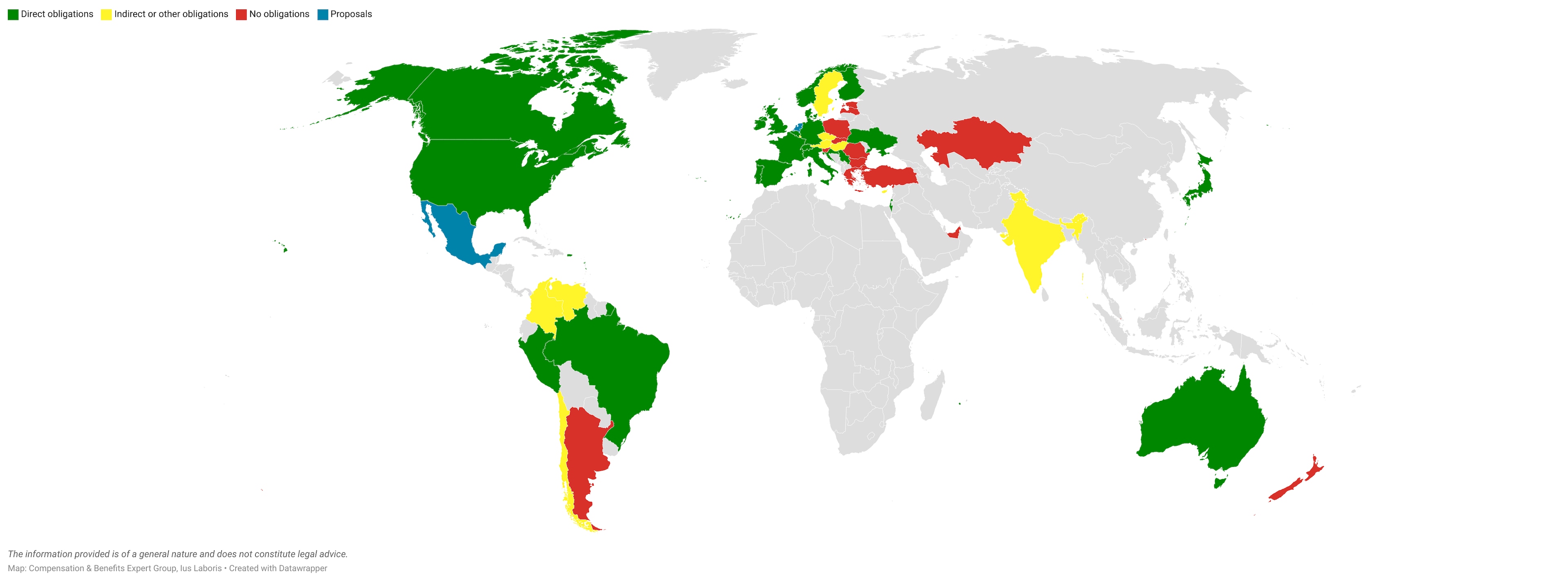Pay transparency and pay gap reporting may be rising but how effective are they?

Gender pay gap and pay transparency has been scrutinized worldwide despite their rise.
Image: Getty Images/iStockphoto
- Many countries have implemented or are moving towards implementing pay transparency and pay gap reporting laws, with mandatory requirements cemented in Europe.
- The comparability of pay gap reporting regimes varies according to the period analyzed, definitions of “pay,” the scope of entities that report and the specific statistics reported, making it difficult to compare and assess policy efficacy.
- The effectiveness of pay gap reporting has been scrutinized. For example, decreases in male pay rather than increased pay to women could explain gap reductions, while pay transparency may weaken bargaining power, meaning pay overall is reduced.
Nearly all countries have one thing in common: a persistent gender pay gap. The gender pay gap represents not just a moral quandary but an inefficient and untenable utilization of human capital. The International Monetary Fund reports that the estimated economic cost of economic disempowerment of women ranges from 10% of gross domestic product in advanced economies to more than 30% in South Asia, the Middle East and North Africa.
Yet, there appears to be a renewed determination to address this longstanding issue. Societal reckonings such as the #MeToo movement have laid bare entrenched inequalities and barriers that permeate workplaces. Governments worldwide are now keen to reduce pay gaps and are adopting pay transparency and reporting measures.
Legislative trends and global consensus?
“Pay transparency” encompasses various policies, from simply publishing pay ranges in job adverts to calculating and publicly reporting pay gaps. This last approach has gained increased traction in recent years.
In 1991, Italy introduced a reporting obligation for large companies concerning male and female employees’ work conditions and salaries. It was only in 2013, however, that the trend really began: Denmark introduced mandatory reporting on gender pay disparities for large companies, with the United Kingdom following suit in 2017.
Several other countries, including France, Spain, Italy, and Ireland, have since introduced similar reporting requirements. In May 2023, the European Union issued its Pay Transparency Directive, which requires all member states to implement gender pay gap reporting obligations and other mechanisms to reduce gender inequality.
Beyond Europe, more countries are joining this movement. In Australia, over 5,000 large employers have recently had their gender pay gaps published. In Brazil, new legislation will oblige companies with more than 100 employees to report salary differences between men and women in management and leadership positions. Japan implemented gender pay gap reporting in 2022. Twenty-one of 38 Organization for Economic Co-operation and Development countries now have a gender pay gap reporting regime.
Devising a gender pay gap reporting regime
Pay reporting at the most basic level involves calculating and publishing statistics about men and women in the workforce. However, there is a high degree of variation between regimes, making comparison difficult.
Below are the questions that any policymaker must consider when devising a gender pay gap reporting regime. The aim is to motivate employers to increase gender diversity in their workplace without imposing too big a burden.
- What period is being analyzed? Using a whole year of data, including variable pay such as commissions, can cause gaps to vary annually due to performance and economic conditions. A snapshot might, therefore, miss significant seasonal differences, leading to incomplete reporting for employers with fluctuating headcounts.
- What is analyzed? Minor changes to the definition of “pay” affect comparability. For example, overtime paid at a premium can significantly impact total compensation, affecting statistics. Similarly, including salary sacrifice or flexible benefits can bias statistics based on personal choice rather than entitlement.
- Who has to report? Reporting obligations typically apply to individual legal entities, but when complex group structures divide a workforce, how many entities will meet the headcount threshold?
- What statistics are reported? The headline statistic always shows the gender pay gap. However, there can be a range of additional statistics relating to bonus gaps, the proportions of men and women who receive benefits, and the proportions within pay quartiles.
- What else is reported? In Ireland, employers must explain the causes of their gaps and any measures they are taking but do not need to take them – saying “We are not taking any measures” is still in statutory compliance. Mandatory explanations are common, but the obligatory proactive reduction is much rarer.
- How is pay reporting enforced? Enforcement tends to be very light touch with those employers that fail to report being “named and shamed” in the media rather than hit with a sanction.
Pay transparency is far from a proven policy.
”Is pay gap reporting effective as a policy?
Gender pay gap reporting is borne from the idea that “sunlight is the best disinfectant.” Rather than legislative micromanagement, employers are left to decide what specific measures to take.
But gender pay gaps change slowly. Knowing whether this type of nudge is an effective policy will take time. Although plenty of examples of employers have been nudged into action, at the macro level, evidence of the effectiveness of pay gap reporting is still developing.
Using data from the United Kingdom, researchers at the London School of Economics found that gender pay gap reporting led to a 1.6% reduction in pay gaps. Similar conclusions have been made about the impact of legislation in Denmark; however, this research found that gaps are reduced due to decreasing male pay rather than increased pay for women. Therefore, the primary motivation for pay reporting – the advancement of women in the labour market – was not achieved.
There is also evidence against pay transparency: one study found that pay transparency could reduce pay by 2%, as it reduces the bargaining position of workers. While this is a theoretical study of negotiation dynamics rather than an empirical study of outcomes, its conclusions shouldn’t be ignored.
These studies indicate that pay transparency is far from a proven policy. Legislators worldwide are, therefore, taking leaps of faith by creating new pay reporting regimes. Although the scale of potential economic, social and political benefits is significant, time will tell whether pay reporting can achieve these.
Accept our marketing cookies to access this content.
These cookies are currently disabled in your browser.
Don't miss any update on this topic
Create a free account and access your personalized content collection with our latest publications and analyses.
License and Republishing
World Economic Forum articles may be republished in accordance with the Creative Commons Attribution-NonCommercial-NoDerivatives 4.0 International Public License, and in accordance with our Terms of Use.
The views expressed in this article are those of the author alone and not the World Economic Forum.
Related topics:
Forum Stories newsletter
Bringing you weekly curated insights and analysis on the global issues that matter.
More on Equity, Diversity and InclusionSee all
Zainab Azizi
April 9, 2025
Jon Jacobson
March 27, 2025
Andrea Willige
March 26, 2025






